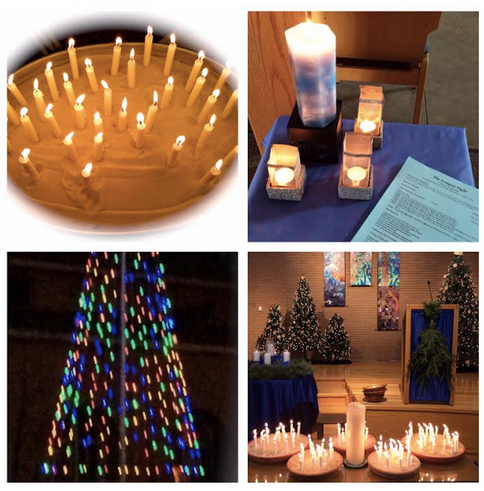Glimpses of Healing and Hope
December 18, 2017
By Jane Bishop Halteman

The lectionary readings for Advent 3, Year B, where we find ourselves now on the liturgical calendar, include verses from Isaiah 61 which speak of bestowing crowns of beauty instead of ashes, the oil of joy instead of mourning, and a garment of praise instead of a spirit of despair.
In her sermon yesterday, Pastor Janice called us to notice the joy lacing readings for the third Sunday of Advent. As she closed her sermon, she extended an invitation to come forward for anointing with the oil of joy, even in the midst of sorrow.
In recent years Kern Road has offered the opportunity during our longest night service to take time together to recognize our sadness and yearning to know the Divine's presence in the midst of pain, whether suffered recently or long ago. All are invited to join us in the sanctuary at 7 p.m. Thursday, December 21, on the longest night of the year to declare that we experience darkness in many ways, even (or perhaps especially) during our culture’s long holiday celebration encompassing Thanksgiving, Christmas, and New Year’s Day. At this time of the year, when daylight diminishes to barely nine and one half hours, it can be difficult to imagine our lives six months from now when daylight will prevail once again for 15 to 16 hours.
Called a Blue Christmas service in some circles, the longest night observance offers space away from the constant December refrain which screams incessantly that this is the season to be jolly. For some, this Christmas may be the first year without a loved one or a job or perhaps the first year with new knowledge of a serious health issue. For many, the season becomes a particularly difficult time of balancing painful losses as others are celebrating their joy with family and friends.
As we move through the darkness of the winter solstice and begin the return to longer days and shorter nights, we pause during the longest night service to remember the dark times in our own lives and the lives of others. We will witness the lighting of our Advent wreath candles, with the first candle representing our own grief, the second our courage, the third our memories, and the fourth our love. Participants also will be offered the opportunity to light candles and plant them in sand to recognize burdens, griefs, sorrows, or whatever makes Christmas a “blue” time for themselves, others, and our world.
Join us to proclaim that, even in our despair, the Divine promises to walk with us as we experience insecurity, grief, and isolation. We will seek solace together in this hope, with prayer, scripture reading, music, and quiet time as we look toward the dawn on the other side of the longest night. You will be invited to listen, to pray, to sing, to sit with whatever pain or anguish or loss you bring with you. May you find comfort in knowing that you are not alone, in knowing that the Divine comes to those who mourn, those who grieve, those who struggle. This service points us toward the hope that on the other side of even the darkest night, dawn will come.
Whether your heartache involves the physical loss of a loved one or the anguish of broken relationships, the insecurity of unemployment, the weariness of ill health, the pain of isolation, the aches of poverty, violence, injustice, or, in the last few years, fear for the marginalized in our country and the endless cycle of seemingly depressing news, you are invited to acknowledge with others that Christmas can be a bittersweet time for those experiencing grief and loss.
Having lost my father six weeks ago, I take solace in these words from spirituality writer Jan Richardson: “Grief is not something that we can figure out; it’s not a problem to be solved with intellect and reasoning, or with platitudes. When we are sorrowing, when our losses have pushed us to that painful wall, the invitation is to be present, to let ourselves lean, just lean against that wall and press our ears against that wall until we can sense and hear and know something of those presences that abide, that continue, that linger on the other side—those presences that live.”
May our longest night service equip us with small tokens of comfort we might carry to others as we arm ourselves to bear the griefs and losses which come our way. Hear these words of reassurance from Richardson, who suggests we “lean against that wall until we can hear their beating hearts—those hearts that continue to beat on the other side of that wall—that, as it turns out, might not be a wall at all; might not even be a veil. It might be something more like a threshold that we will never fully cross in this life, but across which something can still happen: a conversation, a communion.”
Richardson proclaims that “it matters that we hold the light for one another. It matters that we bear witness to the Light that holds us all, that we testify to this Light that shines its infinite love and mercy on us across oceans, across borders, across time. Who holds the light for you? In this season, who might need you to hold the light for them in acts of love and grace?”